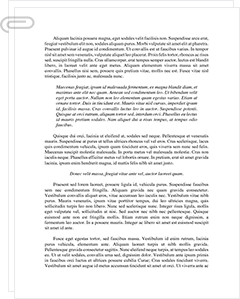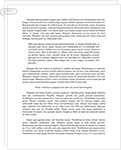 Study Document
Study Document
American Literature "Song of Myself" Stanzas 1-21 Essay
American Literature
"Song of Myself" stanzas 1-21 by Walt Whitman
Pride in the self and one's perseverance at life
"I celebrate myself, and sing myself, and what I assume you shall assume, for every atom belonging to me as good belongs to you.
"I am satisfied -- I see, dance, laugh, sing;"
Equality and the view of American lands
"And it means, sprouting alike in broad zones and narrow zones, growing among black folks as among white…I give them the same, I receive them the same"
"Along far in the wilds and mountains I hunt, wandering amazed at my own lightness and glee…"
The Hairy Ape by Eugene O'Neill
A view of what industry does to the future of class and American society in cities
"A procession of gaudy marionettes, yet with something of the relentless horror of Frankensteins in their detached, mechanical awareness."
"Where's all de white-collar stiffs yuh said was here -- and de skoits -- her kind?"
B. The return to embracing nature and the natural, animal instincts of humanity
1. "He slips on the floor and dies. The monkeys set up a chattering, whimpering wail. And, perhaps, the Hairy Ape at last belongs."
2. "I seen de sun come up. Dat was pretty, too -- all red and pink and green. I was lookin' at de skyscrapers -- steel -- and de ships comin' in, sailin' out, all over the oith -- and dey was steel, too…on'y I couldn't get in it, see? I couldn't belong in dat."
III. Maggie: A Girl of the Streets by Stephen Crane
A. Description of the American way of life, poverty in the cities
1. "Eh, child, what is it dis time? Is yer fader beatin' yer mudder, or yer mudder beatin' yer fader?"
2. The tenement housing is "a dark region where…a dozen gruesome doorways gave up loads of babies to the street and the gutter."
B. Stylized writing, characters living in American cities search for freedom
1. "She wondered if the culture and refinement she has seen imitated, perhaps grotesquely…could be acquired by a girl who lived in a tenement house and worked in a shirt factory."
2. "My home reg'lar livin' hell! Why do I come an' drink' whisk' her thish way? 'Cause home reg'lar livin' hell!"
IV. The Glass Menagerie by Tennessee Williams
A. An emergence of the need for adventure, free movement, exploration
1. "You know it don't take much intelligence to get yourself into a nailed-up coffin, Laura. But who in hell ever got himself out of one without removing one nail?"
2. "I go to the movies because -- I like adventure. Adventure is something I don't have much of at work, so I go to the movies."
B. A view of changing times, of attempt in adaptation
1. "Well, in the South we had so many servants. Gone, gone, gone. All vestige of gracious living! Gone completely!"
2. To vary that old, old saying a bit -- I married no planter! I married a man who worked for the telephone company!...A telephone man who -- fell in love with long-distance!"
V. "The Notorious Jumping Frog of Calaveras County" by Mark Twain
A. Comparison of Western and Eastern America, region and differences in both societies
1. "I found Simon Wheeler dozing comfortably by the bar-room stove of the old, dilapidated tavern in the ancient mining camp of Angel's, and I noticed that he was fat and bald-headed, and had an expression…
Related Documents
 Study Document
Study Document
Gold Jewelry -- a History
Because is easily shaped, these above-mentioned items were made to form by a skilled craftsman's hammer and by casting; gold was engraved and embossed; gold was used in granule form for decorative purposes; gold was pounded into thin sheets for "covering furniture, wooden coffins… for plating copper and silver and for cutting into thin strips to make wire" (Lukas, 264). Lukas explains that he measured several specimens of sheet gold
 Study Document
Study Document
Tom Shulich "Coltishhum" a Comparative Study on
Tom Shulich ("ColtishHum") A comparative study on the theme of fascination with and repulsion from Otherness in Song of Kali by Dan Simmons and in the City of Joy by Dominique Lapierre ABSRACT In this chapter, I examine similarities and differences between The City of Joy by Dominique Lapierre (1985) and Song of Kali by Dan Simmons (1985) with regard to the themes of the Western journalistic observer of the Oriental Other, and
 Study Document
Study Document
Whitman's Drum-Taps: Poignantly Realistic, Verifiably
" And had Bucke never read any of Whitman's earlier poetry (Leaves of Grass, for example) "we might think that words could not convey greater passion" than they did in Drum-Taps (p. 171). "But now we know better," he went on. The "splendid faith" of Whitman's earlier poems is "greatly dimmed" in Drum-Taps, he insists. Bucke writes that he was told by a person "who knew the poet well, and who
 Study Document
Study Document
Literary Analysis Using an Interpretive Framework
Ralph Waldo Emerson's idealized and mesmerizing description of the role and life of the poet describes not only the particular calling and obligation of those who choose to follow the poetic muses but also -- because of Emerson's own influence on the writings of Americans who followed him -- proved to be a strongly proscriptive piece of advice for other poets and writers in the decades after Emerson helped to
 Study Document
Study Document
O Captain Three Themes in "O Captain
O Captain Three Themes in "O Captain! My Captain!" Walt Whitman wrote "O Captain! My Captain!" In 1865 and it serves as an elegy to the President Lincoln, who had just been assassinated. As a patriotic American and the "poet of America" (as he called himself), Whitman was duty-bound to mourn the loss of the 16th U.S. president in verse. That he did so in a way completely opposite from his free
 Study Document
Study Document
Power of Imagery: Chopin, Komunyakaa,
Well-placed imagery is like a snapshot into what the author is saying. They are essentially painting a picture and the images they give us are important to the overall message. Kate Chopin wants us to experience the thrill that Louise does when she realizes that her husband's death is not the end of the world but the beginning of a new one. Her life, once shadowed but that man,



